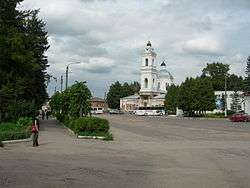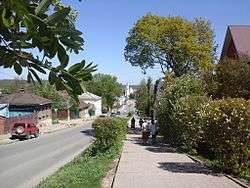Tarusa
| Tarusa (English) Таруса (Russian) | |
|---|---|
| - Town[1] - | |
 Tarusa central square | |
.svg.png) Location of Kaluga Oblast in Russia | |
 Tarusa | |
|
| |
_(1777).png) | |
|
| |
| Administrative status (as of 2013) | |
| Country | Russia |
| Federal subject | Kaluga Oblast[1] |
| Administrative district | Tarussky District[1] |
| Administrative center of | Tarussky District[1] |
| Municipal status (as of October 2013) | |
| Municipal district | Tarussky Municipal District[2] |
| Urban settlement | Tarusa Urban Settlement[2] |
| Administrative center of | Tarussky Municipal District,[2] Tarusa Urban Settlement[2] |
| Statistics | |
| Population (2010 Census) | 9,660 inhabitants[3] |
| Time zone | MSK (UTC+03:00)[4] |
| First mentioned | 1246 |
| Postal code(s)[5] | 249100, 249101 |
| Tarusa on Wikimedia Commons | |
Tarusa (Russian: Тару́са), also known as Tarussa (Тару́сса), is a town and the administrative center of Tarussky District in Kaluga Oblast, Russia, located on the left bank of the Oka River, 76 kilometers (47 mi) northeast of Kaluga, the administrative center of the oblast. Population: 9,660 (2010 Census);[3] 9,893 (2002 Census);[6] 8,795 (1989 Census).[7]
Etymology
The name is from that of the Tarusa River, a tributary of the Oka; Tar- is a hydronym base characteristic of regions of ancient Baltic settlement.[8] According to a popular belief, the name derives from Tarusa's geohistorical position as a border town to the adjoining realm of Lithuania situated on the bank of the Oka. Questions about travelers' whereabouts from the other bank were answered with the answer To—Rus!, meaning "that is Russia," eventually becoming the name of the town.
History
Tarusa is known to have existed since 1246, when it was the capital of one of the Upper Oka Principalities—the Principality of Tarusa. The first ruler of this principality was Grand Duke Yury Mikhaylovich, the son of Grand Duke Mikhail Vsevolodovich of Chernigov. Later, the local rulers moved their seats to Meshchovsk and Boryatino, and Tarusa was subjugated by the Grand Duchy of Moscow in the late 14th century. Tarusa was used as a stronghold at the southern approaches to Moscow in the 15th-17th centuries.
Soviet authority in Tarusa was established on December 27, 1917. In the following years, the town's churches were closed and a monument to Stalin was erected on the central square. During World War II, German troops approached Tarusa and took it on their way to Moscow. The town was occupied by the Germans between October 24 and December 19, 1941. After that, the town was retaken by the Red Army which crossed the Oka River in winter under the frantic German fire and successfully attacked the German strongholds on the higher bank of Oka. Remnants of the town's fortifications and the town wall can still be seen today in the community park near the Peter and Paul Cathedral.

During the Soviet period, Tarusa became the place where many dissidents and people repressed by the Soviet authorities used to settle. Tarusa became the home place for such famous dissident figures as Anatoly Marchenko, Larisa Bogoraz, Gleb Yakunin, Pavel Litvinov, Alexander Ginzburg, Andrey Amalrik, Sergei Kovalev, Zoya Krakhmalnikova, Lev Kopelev, and Frida Vigdorova. The book Tarusa - the 101st kilometer by Tatyana Melnikova is devoted to the lives and fates of the dissidents who lived in Tarusa.
In 1961, Konstantin Paustovsky fought to publish his famous Tarusa Pages, which became the only book in the Soviet Union which escaped Moscow-based central party censorship and offered its pages for various free-thinking and dissident writers. After the book was published, it was declared ideologically harmful and removed from all bookstores and libraries. The director of the Kaluga publishing house was reprimanded, the editor-in-chief was fired, and other repressions were to follow. It was only Paustovsky's personal appeal to Nikita Khrushchev that stopped the wave of planned repressions. Nevertheless, the Tarusa Pages became a significant and meaningful event in the Soviet literature. The book introduced to the public such authors as Bulat Okudzhava, Vladimir Maksimov, Frida Vigdorova, Nadezhda Mandelstam, and Naum Korzhavin, who enjoyed immense popularity in the later years.
Administrative and municipal status
Within the framework of administrative divisions, Tarusa serves as the administrative center of Tarussky District, to which it is directly subordinated.[1] As a municipal division, the town of Tarusa is incorporated within Tarussky Municipal District as Tarusa Urban Settlement.[2]
Culture
The town has a number of popular museums—the Tarusa Regional Museum of Local Lore and the Tsvetayevs Family Museum. It is also home to the Tarusa Town Picture Gallery, which is a branch of Kaluga Regional Museum of Art, boasting a rich collection of such Russian artists as Boris Kustodiev, Nikolay Krymov, Ivan Aivazovsky, Lev Lagorio, and Vasily Polenov.
The Open Russian Festival of Animated Film was held in Tarusa until 2002, after which it was moved to Suzdal.
Economy
Tarusa has an Art Ceramics factory, Institute for Space Research branch, and a milk factory.
Cemeteries
Tarusa has two cemeteries: the Old Cemetery and the New Cemetery. Writer Konstantin Paustovsky, sculptor Vasily Vatagin, Marina Tsvetaeva's daughter Ariadna Efron, builder Sergey Krutilin, and writer Nadezhda Krandievskaya are buried in the Old Cemetery.
References
Notes
- 1 2 3 4 5 Государственный комитет Российской Федерации по статистике. Комитет Российской Федерации по стандартизации, метрологии и сертификации. №ОК 019-95 1 января 1997 г. «Общероссийский классификатор объектов административно-территориального деления. Код 29 238», в ред. изменения №259/2014 от 12 декабря 2014 г.. (State Statistics Committee of the Russian Federation. Committee of the Russian Federation on Standardization, Metrology, and Certification. #OK 019-95 January 1, 1997 Russian Classification of Objects of Administrative Division . Code 29 238, as amended by the Amendment #259/2014 of December 12, 2014. ).
- 1 2 3 4 5 Law #369-OZ
- 1 2 Russian Federal State Statistics Service (2011). "Всероссийская перепись населения 2010 года. Том 1" [2010 All-Russian Population Census, vol. 1]. Всероссийская перепись населения 2010 года (2010 All-Russia Population Census) (in Russian). Federal State Statistics Service. Retrieved June 29, 2012.
- ↑ Правительство Российской Федерации. Федеральный закон №107-ФЗ от 3 июня 2011 г. «Об исчислении времени», в ред. Федерального закона №271-ФЗ от 03 июля 2016 г. «О внесении изменений в Федеральный закон "Об исчислении времени"». Вступил в силу по истечении шестидесяти дней после дня официального опубликования (6 августа 2011 г.). Опубликован: "Российская газета", №120, 6 июня 2011 г. (Government of the Russian Federation. Federal Law #107-FZ of June 31, 2011 On Calculating Time, as amended by the Federal Law #271-FZ of July 03, 2016 On Amending Federal Law "On Calculating Time". Effective as of after sixty days following the day of the official publication.).
- ↑ Почта России. Информационно-вычислительный центр ОАСУ РПО. (Russian Post). Поиск объектов почтовой связи (Postal Objects Search) (Russian)
- ↑ Russian Federal State Statistics Service (May 21, 2004). "Численность населения России, субъектов Российской Федерации в составе федеральных округов, районов, городских поселений, сельских населённых пунктов – районных центров и сельских населённых пунктов с населением 3 тысячи и более человек" [Population of Russia, Its Federal Districts, Federal Subjects, Districts, Urban Localities, Rural Localities—Administrative Centers, and Rural Localities with Population of Over 3,000] (XLS). Всероссийская перепись населения 2002 года [All-Russia Population Census of 2002] (in Russian). Retrieved August 9, 2014.
- ↑ Demoscope Weekly (1989). "Всесоюзная перепись населения 1989 г. Численность наличного населения союзных и автономных республик, автономных областей и округов, краёв, областей, районов, городских поселений и сёл-райцентров" [All Union Population Census of 1989: Present Population of Union and Autonomous Republics, Autonomous Oblasts and Okrugs, Krais, Oblasts, Districts, Urban Settlements, and Villages Serving as District Administrative Centers]. Всесоюзная перепись населения 1989 года [All-Union Population Census of 1989] (in Russian). Институт демографии Национального исследовательского университета: Высшая школа экономики [Institute of Demography at the National Research University: Higher School of Economics]. Retrieved August 9, 2014.
- ↑ Е. М. Поспелов. "Географические названия мира". Москва, 1998, p. 411.
Sources
- Законодательное Собрание Калужской области. Закон №369-ОЗ от 1 ноября 2004 г. «Об установлении границ муниципальных образований, расположенных на территории административно-территориальных единиц "Думиничский район", "Кировский район", "Медынский район", "Перемышльский район", "Сухиничский район", "Тарусский район", "Юхновский район", и наделении их статусом городского поселения, сельского поселения, муниципального района», в ред. Закона №728-ОЗ от 29 мая 2015 г. «О внесении изменений в Закон Калужской области "Об установлении границ муниципальных образований, расположенных на территории административно-территориальных единиц "Думиничский район", "Кировский район", "Медынский район", "Перемышльский район", "Сухиничский район", "Тарусский район", "Юхновский район", и наделении их статусом городского поселения, сельского поселения, муниципального района"». Вступил в силу после вступления в силу Закона Калужской области "Об изменении статуса населённых пунктов, расположенных на территории административно-территориальных единиц "Думиничский район", "Кировский район", "Медынский район", "Перемышльский район", "Сухиничский район", "Тарусский район", "Юхновский район" Калужской области", но не ранее чем через десять дней после его официального опубликования. Опубликован: "Весть", №336–338, 10 ноября 2004 г. (Legislative Assembly of Kaluga Oblast. Law #369-OZ of November 1, 2004 On Establishing the Borders of the Municipal Formations Located on the Territory of the Administrative-Territorial Units of "Duminichsky District", "Kirovsky District", "Medynsky District", "Peremyshlsky District", "Sukhinichsky District", "Tarussky District", "Yukhnovsky District", and on Granting Them the Status of an Urban Settlement, Rural Settlement, Municipal District, as amended by the Law #728-OZ of May 29, 2015 On Amending the Law of Kaluga Oblast "On Establishing the Borders of the Municipal Formations Located on the Territory of the Administrative-Territorial Units of "Duminichsky District", "Kirovsky District", "Medynsky District", "Peremyshlsky District", "Sukhinichsky District", "Tarussky District", "Yukhnovsky District", and on Granting Them the Status of an Urban Settlement, Rural Settlement, Municipal District". Effective as of after the Law of Kaluga Oblast "On Changing the Status of the Inhabited Localities Located on the Territory of the Administrative-Territorial Units of "Duminichsky District", "Kirovsky District", "Medynsky District", "Peremyshlsky District", "Sukhinichsky District", "Tarussky District", "Yukhnovsky District" of Kaluga Oblast" takes effect, but no earlier than after ten days since the official publication have passed.).